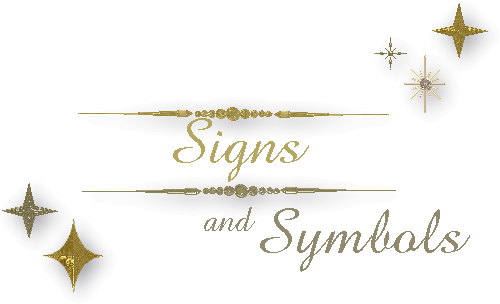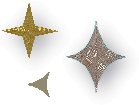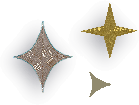
 +++Representing God and the Saints+++ THE ELEMENTS ASHES: In Catholic symbolism, ashes are the symbol of penitence. On Ash Wednesday, the first day of Lent, ashes placed on the forehead express the penitential nature of the season. The ashes are from the palms of the previous Palm Sunday. Ashes also represent the death of the human body and symbolize the shortness of earthly life and to remind the person receiving the ashes of whence he came, from the dust of the earth, and to which he will return when he is buried. CARBUNCLE: The deep blood-red of the carbuncle is significant of blood and suffering, hence the stone is considered to be symbolic of Christ's Passion and of Martyrdom. Five carbuncles are sometimes shown on the Cross to symbolize the five wounds received by Christ during the Crucifixion. CLOUDS: Clouds in the heavens are the natural veil of the blue sky, and are, therefore, used as the symbol of the unseen God. A hand emerging from a cloud is the most common symbol of Divine Omnipotence. CORAL: In pictures of the Christ Child it denotes protection against evil. Seldom used in art today. DARKNESS: Physical darkness is the symbol of spiritual darkness. The Devil is the Prince of Darkness. In his realm, all is dark; while in the realm of God, all is light. DAWN: Dawn is the symbol of the Blood of Christ. Through the shedding of His Blood, the darkness of sin was overcome, and the dawn of eternal salvation made the world light. It is with this meaning that, in paintings of the Resurrection, Christ sometimes appears clothed in the rose color of dawn. Dawn is also the symbol of the Advent of Christ. EARTH: The earth, which produces plants and trees and furnishes a habitation for man, is often used as a symbol for the Church, which feeds man with spiritual faith and offers him shelter. Thus, the earth, in which the Cross was planted, sometimes conveys this symbolic meaning. EAST: East, being the direction in which the sunrise appears, is symbolic of Christ, the Sun of the Universe. Traditionally churches have been erected in such wise that the main altar was set in the east direction. Tradition tells us that Christ's second coming will be from the East. It is significant that Russia, which is in easternmost Europe will be the font of conversion once it is actually consecrated to the Immaculate Heart of Mary. Moreover, the Magi followed the Eastern Star to find their Savior King in the holy manger. "Sing ye to God Who mounteth above the heaven of heavens, to the east." [Psalm 67:33-34] FIRE AND FLAMES: Fire and flames are symbolic of both Martyrdom and religious fervor. Flames of fire are an attribute of St. Anthony of Padua, the patron Saint of protection against fire. St. Lawrence sometimes wears a burning tunic, in reference to his torture on a gridiron. Fire or flames may appear as attributes to signify the fervor of such Saints as St. Anthony Abbot, St. Vincent Ferrer and St. Agnes. Fire itself is sometimes personified as a monster vomiting flames; or by a salamander, which, according to an ancient legend, can live in fire without being burned. The salamander is almost never used anymore, although symbols in art based on fictional accounts often remain in use, not to perpetuate the myth itself, but because of what the symbol represents in spiritual terms. In paintings of Pentecost, flames on the heads of the Apostles signify the presence of the Holy Ghost. They also signify the torments of Hell. FOUNTAIN: The fountain is one of the attributes of the Virgin Mary, who is the 'fountain sealed up' [Canticles 4:12] and upon Psalm 35:10, which reads, 'For with thee is the fountain of life: in thy light shall we see light.' The fountain is also the attribute of St. Clement who miraculously found water in the desert for his followers. GARDEN: The enclosed garden is a symbol of the Immaculate Conception of the Virgin Mary. The symbol is borrowed from the Canticles 4:12, 'My sister, My spouse; is a garden enclosed, a garden enclosed, a flower sealed up.' GOLD: The precious metal, gold, is used as the symbol of pure light, the heavenly element in which God lives. It is also used as a symbol of worldly wealth and idolatry. This is based on the story of Aaron [Exodus 32], who, in the absence of Moses, fashioned a golden calf which was to be worshiped instead of the true God. HARBOR: The harbor, according to some authorities, is a symbol of eternal life, and the ships making for the harbor are likened to souls in search of Heaven. HONEY: The purity and sweetness of honey have made it a symbol of the work of God and the ministry of Christ. Paradise, the reward of the faithful in their labors for Christ, is known as 'the land of milk and honey.' IVORY: Ivory has two outstanding qualities: the whiteness of its color and the firmness of its texture. From these qualities come the symbols of purity and moral fortitude. Ivory, is, on occasion, a symbol of Christ, in reference to the incorruptibility of His Body in the tomb. Thus the origin of the custom of carving crucifixes from ivory. LIGHT: Light is symbolic of Christ, in reference to His words in John 8:12, 'Again therefore, Jesus spoke to them, saying: I am the Light of the world: he that followeth Me, walketh not in darkness, but shall have the light of life.' NORTH: North has always been considered as the region of cold and night. In the early centuries of the Church, the barbarians lived to the north. The reading of the Gospel from the north end of the altar symbolized the Church's desire to convert the barbarians to Christ. OIL: Oil is the symbol of the Grace of God. It is used in the Sacraments of Baptism, Confirmation, Ordination, and Extreme Unction. PEARL: The pearl, as the 'most precious jewel,' is used as a symbol of salvation, which is worth more than all the treasures of earth. 'The Kingdom of Heaven,' said Christ, according to Matthew 13:45, 'is like unto a merchant man, seeking goodly pearls; who, when he had found one pearl of great price, went and sold all that he had, and bought it.' Elsewhere in Matthew the pearl represents the word of God: 'Give not that which is holy unto the dogs, neither cast ye your pearls before swine, lest they trample them under their feet . . .' [Matthew 7:6]. PITCH: Pitch, because of its color and clinging quality, is a symbol of evil. 'Black as pitch' is a familiar phrase used to denote a sinful state or condition. RAINBOW: The rainbow is a symbol of union and, because it appeared after the Flood, it is also the symbol of pardon and of the reconciliation given to the human race by God. In art, the rainbow is used as the Lord's throne, and in representations of the Last Judgment, Christ is often seated upon it. '. . . behold, a throne was set in Heaven, and one sat on the throne . . . and there was a rainbow round about the throne.' [Apoc. 4:2, 3]. RIVERS: According to ancient tradition, there were four sacred rivers: the Pison, the Gihon, the Tigris, and the Euphrates. These rivers were believed to be the four rivers of Paradise, flowing from a single rock, and as such were used as symbols of the four Gospels flowing from Christ. ROCKS: Rocks are a symbol of the Lord. This meaning is derived from the story of Moses, who smote the rock from which a : spring burst forth to refresh his people. Christ is often referred to as a rock from which flow the pure rivers of the Gospel. St. Peter, too, is referred to as the Rock, the cornerstone of the Church, because of Christ's statement: '. . .that thou art Peter, and upon this Rock I will build My Church . . .' [Matthew 16:18]. SALT: Salt is the symbol of strength and superiority. Christ, in the Sermon on the Mount, called His disciples 'the salt of the earth' [Matthew 5:13]. Since salt protects food from decay, it is sometimes used as a symbol of protection against evil and, in this context, is placed in the mouth of the child being Baptized. There is a blessing for salt which can be placed on a window sill or elsewhere to ward off evil. SILVER: Because of its whiteness and because it is a precious metal tested by fire, silver has become the symbol of purity and chastity . Silver also is symbolic of the eloquence of the evangelist. These concepts are based upon Psalm 11:7, which states: 'The words of the Lord are pure words: as silver tried in a furnace of earth, purified seven times.' SMOKE: Smoke has come to suggest vanity and all that is fleeting because it rises into the air only to disappear. Symbolically, it is a reminder of the shortness of this life and the futility of seeking earthly glory. The anger and wrath of God were ofttimes indicated by smoke. 'O God, why hast Thou cast us off for ever? Why doth Thine anger smoke against the sheep of Thy pasture?' [Psalm 73:1]. SOUTH: South, as one of the cardinal points, is the seat of light and warmth; it is therefore associated with the New Testament, especially the Epistles. STAR: The star, lighting the darkness of the heavens at night, is a symbol of Divine guidance or favour. The Star of the East, often seen in pictures of the Magi, was the star that guided the wise men to Bethlehem and stood in the sky over the manger where Christ was born. Twelve stars may symbolize the twelve tribes of Israel and the twelve Apostles. The Virgin of the Immaculate Conception and the Queen of Heaven is crowned with twelve stars [Apoc. 12:1]. One star is a symbol of the Virgin in her title 'Stella Maris,' Star of the Sea. A star on the forehead is one of the attributes given to St. Dominic, while a star on the breast is an attribute of St. Nicholas of Tolentino. STONES: Stones are symbols of firmness. They are used as an attribute of St. Stephen, who was stoned to death. St. Jerome is frequently portrayed at prayer beating his breast with a stone. SUN AND MOON: The sun is symbolic of Christ, this interpretation being based on the prophecy of Malachi 4:2: 'But unto you that fear myname shall the Sun of Justice arise and health in his wings.' The sun and moon are used as attributes of the Virgin Mary, referring to the 'woman clothed with the sun, and the moon under her feet' [Apoc. 12:1]. The sun and moon are often represented in scenes of the Crucifixion to indicate the sorrow of all creation at the death of Christ. St. Thomas Aquinas is sometimes depicted with a sun on his breast. WATER: Water is a symbol of cleansing and purifying. In this sense it is used in the Sacrament of Baptism, symbolizing the washing away of sin and the rising to newness of life. It also denotes innocence, as when Pilate publicly washed his hands, saying, 'I am innocent of the Blood of this just Man' [Matthew 27:24]. More rarely, water suggests trouble or tribulation: 'Save me, O God; for the waters are come even into my soul . . . I am come into the depth of the sea: and a tempest hath overwhelmed me.' [Psalm 68: 1, 2]. The water, mixed with wine, in the Eucharist has come to denote Christ's Humanity, the wine representing His Divinity. WELL: The well or fountain is the symbol of Baptism, of life and rebirth. The flowing fountain symbolizes the waters of eternal life. The sealed well or fountain is a symbol of the virginity of Mary. WEST: As one of the four cardinal points, the west signifies the seat of darkness and the abode of demons. To those sitting in the darkness, the rose window high up on the western side of the church was said to make the light of the Gospel visible. WINGS: Wings are the symbol of Divine mission. That is why the Angels, Archangels, Seraphim, and Cherubim are painted with wings. The emblems of the four evangelists, the lion of St. Mark, the ox of St. Luke, the man of St. Matthew, and the eagle of St. John, are all depicted as winged creatures. The moon in the image above is an actual photo I shot early in the morning as dawn was taking over, the very day I beagn work on this section. The threaded clouds background is an actual sky photo from our backyard the same week. The image of Our Lady is copyrighted by Catholic Tradition.  E-Mail E-Mail HOME------------------SAINTS------------------PATRONS www.catholictradition.org/Saints/signs3.htm |